Baroque sculpture
.jpg)
Baroque sculpture is the sculpture associated with the Baroque cultural movement of the period between the early 17th and late 18th centuries. In Baroque sculpture, groups of figures assumed new importance, and there was a dynamic movement and energy of human forms—they spiralled around an empty central vortex, or reached outwards into the surrounding space. Baroque sculpture often had multiple ideal viewing angles, and reflected a general continuation of the Renaissance move away from the relief to sculpture created in the round, and designed to be placed in the middle of a large space—elaborate fountains such as Bernini's Fontana dei Quattro Fiumi (Rome, 1651), or those in the Gardens of Versailles were a Baroque speciality. The Baroque style was perfectly suited to sculpture, with Gian Lorenzo Bernini the dominating figure of the age in works such as The Ecstasy of St Theresa (1647–1652).[1] Much Baroque sculpture added extra-sculptural elements, for example, concealed lighting, or water fountains, or fused sculpture and architecture to create a transformative experience for the viewer. Artists saw themselves as in the classical tradition, but admired Hellenistic and later Roman sculpture, rather than that of the more "Classical" periods as they are seen today.[2]
Baroque sculpture followed Renaissance and Mannerist sculpture and was succeeded by Rococo and Neoclassical Sculpture. Rome was the earliest centre where the style was formed. The style spread to the rest of Europe, and especially France gave a new direction in the late 17th century. Eventually it spread beyond Europe to the colonial possessions of the European powers, especially in Latin America and the Philippines.
The Protestant Reformation had brought an almost total stop to religious sculpture in much of Northern Europe, and though secular sculpture, especially for portrait busts and tomb monuments, continued, the Dutch Golden Age has no significant sculptural component outside goldsmithing.[3] Partly in direct reaction, sculpture was as prominent in Catholicism as in the late Middle Ages. Statues of rulers and the nobility became increasingly popular. In the 18th century much sculpture continued on Baroque lines—the Trevi Fountain was only completed in 1762. The Rococo style was better suited to smaller works.[4]
Characteristic
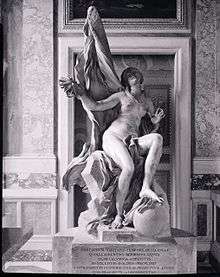
The architecture, sculpture and fountains of Bernini (1598–1680) give highly charged characteristics of Baroque style. Bernini was undoubtedly the most important sculptor of the Baroque period. He approached Michelangelo in his omnicompetence: Bernini sculpted, worked as an architect, painted, wrote plays, and staged spectacles. In the late 20th century Bernini was most valued for his sculpture, both for his virtuosity in carving marble and his ability to create figures that combine the physical and the spiritual. He was also a fine sculptor of bust portraits in high demand among the powerful. Bernini died in 1680 but his heritage was absorbed by sculptors painters and architects in their work in the first half of the 18th century particularly in Bavaria, France and Austria.
Baroque sculpture in Rome
Rome became the most productive place of Baroque sculpture in the 17th century. As Centre of Christian movement, but also a great economic and dipolomatic predisposition guaranteed the arrival of the new style just around the old ancient city. Expansion of the new town is already mentioned at the pontificate of Sixtus V, who initiated to create a new urban concept in 1585 by Renaissance artist Giacomo della Porta. However, the beginning of Baroque ideas in Rome was starting to develop at the pontificate of Paul V With the formation of new opinions dependent on the Council of Trent, there was appearing artists with innovative approaches representing the new requirements.
Paul V
At the beginning of 17th century there was appearing artists with own sculptural approach in Rome. Their art was still referring Mannerist period, but in some aspects predetermine the development of sculpture in the future time. Many of them worked in the service of Paul V. As his most sculptural achievement can be considered Cappella Paolina in Basilica di Santa Maria Maggiore, one of the first baroque chapels.
The oldest of them, Pietro Bernini, originally from Florence, worked most of his life in Naples. In 1606 he moved with his son Gian Lorenzo Bernini in Rome, where he began working among others in the service of Paul V. His style derived from Hellenistic sculptures became one of the first inspiration for young Gian Lorenzo, who shaped sculpture in the coming years.
Stefano Maderna came from Rome, where he worked throughout his life. In addition to the inspiration of the Hellenistic and Renaissance sculpture he dealt with its own innovative approach. His most famous work of St. Cecilia in the Church of St. Cecilia, in many aspects signal the mysthic expression of Ecstasy of St. Theresa.
Francesco Mochi was born in Florence. In 1599 he moved to Rome, where he began to make up for Paul V. His dynamic style is strongly inspired by Giambologna, but, his works more closely represent religious theme.
- Boy with Dragon (1617) by Pietro Bernini
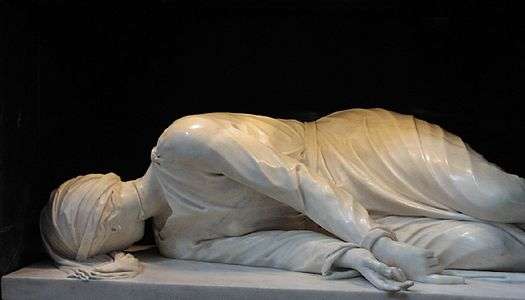 St. Cecilia (1599) by Stefano Maderno
St. Cecilia (1599) by Stefano Maderno_de_Francesco_Mochi.jpg) Annonciation (1605) by Francesco Mochi
Annonciation (1605) by Francesco Mochi
Gian Lorenzo Bernini was born in Naples, but shortly after his birth, his family moved in 1605 to Rome. Sculptural learning gained in the workshop of his father Pietro Bernini. He received recognition already during their studies and also through admiration of Paul V. He get his first contract by Scipione Borghese, nephew of Pope and patron of Baroque art. His early works was modeled after his father dealing with ancient motives, transferred in Hellenistic form. However, his innovation brings new compositions representing certain situation of mythological stories. Thanks to this aspect Bernini applied image of strongly dramatic scene representing the motion. Furthermore, unlike renaissance sculptures, he situated the arrangement of the whole scene in one clearly legible view.
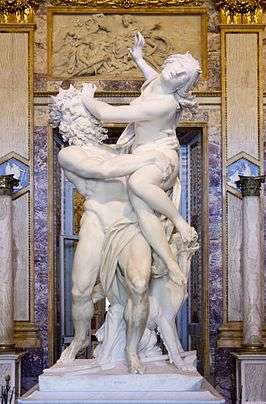 Rape of Proserpina (1621–1622) by Gian Lorenzo Bernini
Rape of Proserpina (1621–1622) by Gian Lorenzo Bernini.jpg) Apollo and Daphne (1622–1625) by Gian Lorenzo Bernini
Apollo and Daphne (1622–1625) by Gian Lorenzo Bernini- David (1623–1624) by Gian Lorenzo Bernini
Urban VIII.
The election of Urban VIII as the new leader of the Papal States, created new conditions for the expansion of baroque sculpture. Gian Lorenzo Bernini got the favour of the new Pope so he obtained the post of Papal sculptor. His methods, which he mainly used for private commissions, were now progressively applied in the Christian world. The rise of drama, theatricality and emotionalism began to be placed in public space, and soon it became a popular way of presentation. The new sculpture established all aspects and ideas connected with the Council of Trent. It supported devotion of believers and statues began to serve as a medium with God and the model for every Christian.
There was many sculptural commissions during the period of Urban VIII. The first of them was a statue of Saint Bibiana created with connection of rediscovering of the body of Saint at the beginning of the pope's pontificate. Works was given to Gian Lorenzo Bernini, who made new model of the saint depicting the emotional and dramatic character of figure.
Most important work of Bernini during the papacy of Urban VIII related with the Basilica of Saint Peter in Vatican. In 1626 the new basilica was consecrated and the work of the decorations in the interior began. The first phase of this concept was the creation of the new Baldachin of Saint Peter with the main altar. Construction in the form of ciborium was made of bronze between 1623–1634. The next step of the works of basilica was to create sculptural arrangement of the central space. Bernini designed the project with the sculptures of four saints placed at the huge pillars bearing Michelangelo´s dome. Works of the four statues was given to the hands of sculpture masters of Rome. Giann Lorenzo Bernini, Francesco Mochi, Andrea Bolgi and Francoise Duquesnoy and their placing in the niches ended 1640 with the statue of Saint Veronica.
 Saint Bibiana (1624–26) by Gian Lorenzo Bernini
Saint Bibiana (1624–26) by Gian Lorenzo Bernini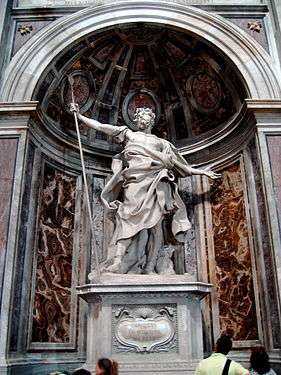 Saint Longinus (1629–38) by Gian Lorenzo Bernini
Saint Longinus (1629–38) by Gian Lorenzo Bernini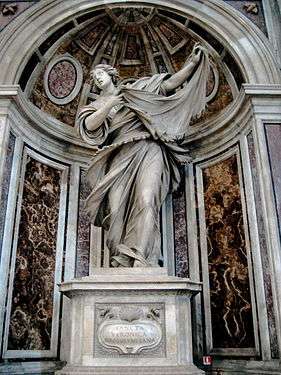 Saint Veronica (1629–1640) by Francesco Mochi
Saint Veronica (1629–1640) by Francesco Mochi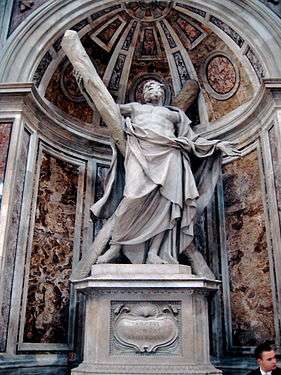 Saint Andrew (1629–1640) by Francois Duquesnoy
Saint Andrew (1629–1640) by Francois Duquesnoy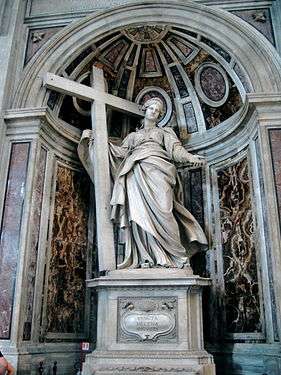 Saint Helena (1629–1639) by Andrea Bolgi
Saint Helena (1629–1639) by Andrea Bolgi
Innocent X
In 1644 he was elected as a new officer of Papal States Pope Innocent X, who followed the ideas of his predecessor. During his pontificate, production of art still remained in attention of Christian spreading, but his aversion against Gian Lorenzo Bernini led to some particular changes in development of Baroque style. Post of papal sculptor than gained less known Alessandro Algardi, whose workshop has become the second most popular in Rome, immediately after Bernini's workshop.
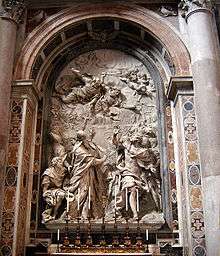
Alessando Algardi was born and trained in Bologna in the famous workshop of brothers Carraci. In 1625, after short trip to Mantua, he moved to Rome, where he later established his own studio. Artistic reputation gained first mainly by private contracts for the Roman aristocracy, especially by works of sculptural portraits in the form of busts. His own style is in many ways classified to the group of the Bologna school, which main typical feature is a fusion of traditional classical ideas with new Baroque opinions. His inspiration by antique is the moste visible at Tomb of Pope Leo XI created between 1634–44, for which Algardi gained fame around the whole Rome. After that he gained popularity with the Pope Innocent X, too. He was promoted to the post of papal sculptor and commissioned by many works for him. His style was during this period more and more influenced by baroque methods and his sculpture became more dynamic, dramatic and emocional. But still they kept their classic reference and did not link up completely to new approaches. His most popular work is a relief Fuga d'Attila created between 1646–53 and located in St. Peter's Basilica. With this work introduces a new type of monumental reliefs, which replaced the painted altarpieces for a short time. Many younger artists working in Rome later worked on similar works inspired by this relief.
François Duquesnoy was born in Brussels and he was trained in the workshops of his father. During his studies he has built favour with the Dutch Grand Duke and in 1618 he was sent at study in Rome. During his stay in city he was mainly focused on study of ancient monuments, where he sought the inspiration for creation of his own classical style. His sculptural work was based on idealistic embodiment of perfect forms of figuration and expressive characterisation. In this way, it differed from Baroque dynamism and dramatic. Instead, he use more innovative forms to image of emotion and mood. This form of soft Baroque then influenced mainly artists working in the late 17th and early 18th century. Duquesnoy work belong, among Bernini's and Algardi's work, to a radical impact affecting the development of Baroque art. His famous work is Santa Susana in Santa Maria di Loreto in Rome made between 1629–33.
Alexander VIII
After the death of Innocent XI in 1655, became the new Pope Fabio Chicgi, one of the descendants of the famous Roman family. Under the new papal name of Alexander VII he continued in spreading of Baroque style in Rome and even in sculpture. During his pontificate, Gian Lorenzo Bernini got again the position of main papal artist and there has been committed several important orders into his hands. Already in 1656 he began construction of Piazza di San Pietro, along with a colonnade decorated with many sculptural figures. 96 sculptures formed along with his collaborators and pupils represent the most important saints of the Catholic Church.
Italian Baroque sculptors
Baroque sculptors in France and Flanders
Baroque sculptors in Spain
Baroque sculptors in Habsburg Monarchy and Germany
Baroque sculptors in Latin America
Aleijadinho in Brazil was also one of the great names of baroque sculpture, and his master work is the set of statues of the Santuário de Bom Jesus de Matosinhos in Congonhas. The soapstone sculptures of old testament prophets around the terrace are considered amongst his finest work.
Notes
- ↑ Boucher, 134–142 on the Cornaro chapel; see index for Bernini generally
- ↑ Boucher, 16–18
- ↑ Honour and Fleming, 450
- ↑ Honour and Fleming, 460–467
References
| Wikimedia Commons has media related to Baroque sculptures. |
- Boucher, Bruce, Italian Baroque Sculpture, 1998, Thames & Hudson (World of Art), ISBN 0500203075
- Hugh Honour and John Fleming, A World History of Art, 1st edn. 1982 (many later editions), Macmillan, London, page refs to 1984 Macmillan 1st edn. paperback. ISBN 0333371852